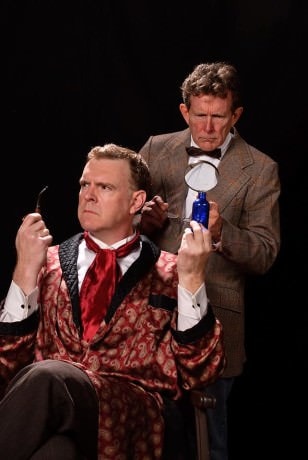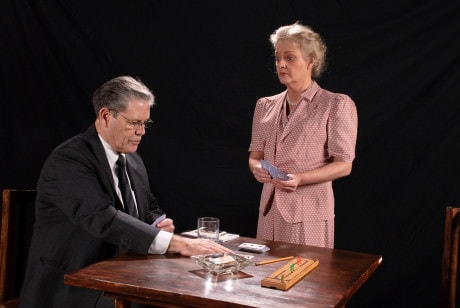Colonial Players of Annapolis’ production of Shiloh Rules is a funny, yet thought-provoking play, a wonderful way to begin their 69th season. Written by Doris Baizley and directed by Beth Terranova, it feels incredibly timely given the current political and racial climate, where it seems like the legacy of the Civil War and its lessons are still being fought.
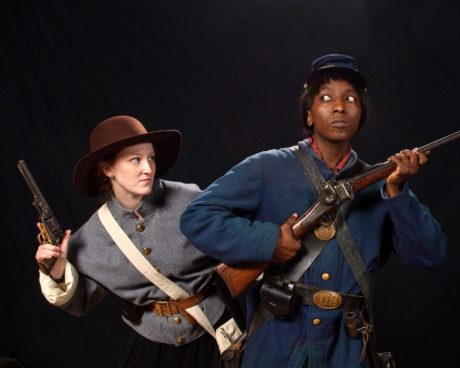
The play takes place at Shiloh Battlefield Park, where two sets of Civil War re-enactors are preparing for the re-creation of the battle. Laura Ivey plays Meg Barton, a new participant playing the part of a Union nurse. She radiates eagerness and preparation for the role, having memorized her fictional history, and seems ready to assist the wounded soldiers. She shows some skepticism, though, wondering if her nursing skills will be truly needed. During the rawness of the battle, her enthusiasm visibly slackens, but it returns when she finds her skills unexpectedly useful.
Jamie Erin Miller plays Meg’s mentor, Clara May Abbott. She plays her role with joyful enthusiasm, grateful to have a cause that she fully believes in. That eagerness gets replaced by fear during the battle, overwhelmed by the smoke, sights, and sounds of war. She breaks down in tears, tripping over her medical supplies, and finds herself reacting in unexpected and surprising ways, exclaiming in one scene “I don’t like this world anymore.” She gives a powerfully emotional performance that is compelling to watch.
Carrie Brady plays LucyGale Scruggs, on the Confederate side, with youthful energy and rebelliousness. She begins the play reading a letter, and when challenged about her literacy given her fictional history, offers a few convincing possibilities. Her enthusiasm is clear; when the battle starts, she yearns to be out on the front lines, fighting with the men. Given a mission, she throws herself into the cause, violently struggling with Clara. Later, in a vulnerable moment, she reveals her “real” history, and her reasons for becoming a re-enactor.
Meg Venton gives LucyGale’s mentor, Cecilia Delaunay Pettison, an air of both mystery and authority. At first, she seems like just an overly dedicated, zealous re-enactor, not breaking character even when asked for her driver’s license. But there is more to her that cannot be explained. She speaks to the unknown soldiers buried in the park, calling them by name. She decries the Union’s assault on Confederate towns with the passion of someone who lived through it. Accusing LucyGale of being a spy, she pulls a gun on the young woman. It is hard not to feel sympathy for her, especially when she remarks “every time I come here, I lose.” She gives a remarkable performance.
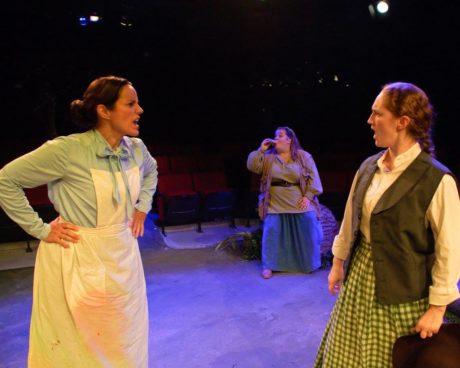
Shannon Benil plays the Widow Beckwith with humor and a drop of cynicism. A profiteer, she comes onstage with a rolling bag full of seemingly authentic equipment to sell to both sides, as well as beer. She eagerly and wittily breaks park rules to ply her trade. In some ways, she straddles both the re-enactors’ world and the real one, giving details of the battle while acknowledging the irrelevance of re-fighting it.
Ashley Spooner plays Ranger Wilson with complexity and nuance. She has no tolerance for either side of the re-enactors, determined to enforce park rules and write up every violation. When the battle happens unexpectedly, she finds herself in the middle, resorting to unusual methods to restore order. Seeing the Confederate flag, she shudders, explaining “I didn’t know how that would make me feel.” Caught up in the battle, she feels both the intensity of the history, and the artifice of re-enacting it.
Beth Terranova and Jeannie Christie have done wonderful work as costume designers. The outfits certainly have the feel of authenticity, even while they are supposed to be re-creations. Clara and Meg look like Civil War nurses, in white shirts and smocks. LucyGale wears a vest, a checkered skirt, and a large, floppy hat. Cecilia has a beige dress with a long skirt, and a cap, the very image of an antebellum Southern woman. Ranger Wilson wears a full Ranger’s uniform, complete with a cap and a badge. At one point, two characters dress in Confederate and Union soldiers’ uniforms, making for a striking scene.
Lois Banscher and Constance Robinson, as properties designers, have done great work. The props, from the lanterns to the tools in Clara and Meg’s medical kit, all look like they come straight from a Civil War battlefield. Even the handguns look authentic. It helps make everything feel incredibly real.
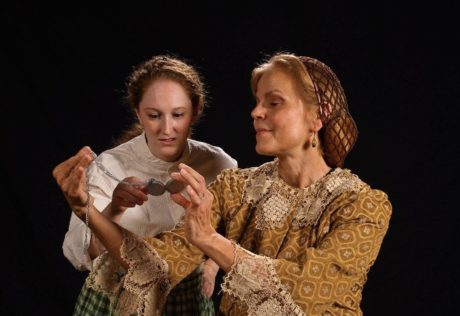
Alex Brady as lighting designer and Ben Cornwell as sound designer work well together, helping to create a spooky, mysterious atmosphere. There are flashes of lightning and the sound of thunder, as well as cannon blasts and men charging. With the lights turned low to reflect nighttime, it truly feels as though a battle were going on just around the corner.
Set Painting Designer Jane Wingard has created a powerful set. Tree stumps of various sizes are scattered throughout the stage, surrounded by patches of grass. Offstage, on the far left, is a beautiful painting of a lake and woods, meant to evoke more of the park. It is seemingly simple, yet works perfectly.
Beth Terranova has done a terrific job as director. The actors work well together, and walk around the stage and each other effortlessly. They are an incredibly talented group, with four of them playing not only their modern-day characters, but also their Civil War figures they have created for themselves. Watching them navigate and sometimes struggle between their different roles is amazing theater. Everything comes together to make Shiloh Rules a powerful production, that will have audiences laughing and thinking at the same time.
You’ve got to hurry if you want to see Shiloh Rules, though; the final weekend of this impactful show starts TODAY, Thursday, September 28.
Running Time: Approximately one hour and 50 minutes, with a 10-minute intermission.

Shiloh Rules plays through October 1, 2017 at Colonial Players of Annapolis – 108 East Street, in Annapolis. For tickets, call the box office at 410-268-7373 or purchase them online.


